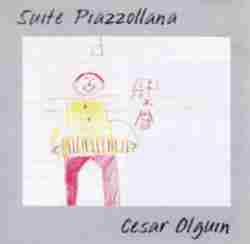
Program:
El tiempo y el olvido (Prólogo)
Operación Sur
Milgonón
Apiazzolla-do
En París también se muere
Quilombero
Astorpia
Doneonba
El tiempo y el olvido (Final)
Total time: 63:58
Released: 1995
review date: March 1999
Label: Discos Pentagrama, S. A. de C. V.
Order from: César Olguín
email: bando@df1.telmex.net.mx
Review by Gregory A. Vozar:
For bandoneonist and composer César Olguín, this recording of Suite Piazzollana is his means of paying tribute to Astor Piazzolla, a seminal figure in South American music. In his album notes, Olguín states unequivocally that even though he never studied or met with Piazzolla, he considers this man to be his most important teacher. For the world at large, Piazzolla's posthumous influence and fame continue to grow; recently several internationally recognized musicians have made recordings of his tango nuevo compositions.
A brief glance will highlight parallels between the two men. Both Piazzolla and Olguín chose the same means of personal expression: the bandoneon. They also share a bond of ethnicity, for both were born in Argentina and lived outside their native land for periods of time. Finally, their compositions share a distinctly Argentine parentage: the rhythm, sensuality, and yearning of tango are at their foundation. Nevertheless, I believe what may have inspired Olguín more than the any of the above, is the intensely personal nature of Piazzolla's music. It is one of those odd dichotomies of life that the more intimately one expresses the core of oneself, the more universally understood one's language becomes. In revealing aspects of himself so minutely, Piazzolla pointed to where they lie within each of us. In this way César Olguín found the key to his own musical voice.
Besides Astor Piazzolla, there are other influences that press noticeably on my ears as I listen to this recording. Repeated melodic fragments are a compositional device Piazzolla used, but Olguín often employs them in a fashion reminiscent of Phillip Glass. There is a upward modulating, repeated harmonic figure near the end of "Doneonba" that leaves no doubt that Phillip Glass has also swayed Olguín's musical ideals.
Olguín's Suite is divided into nine movements, the final one being a reprise with variations of the opening "El tiempo y el olvido" (Time and Forgetfulness). Considering the above, it comes as no surprise that the rest of the titles read much like the tracks on a Piazzolla CD. These include two that play on that composer's name: "Astorpia" and "Apiazzolla-do," the latter being a pun that roughly translates as "Piazzollized". Another bit of creative vocabulary building includes the title "Quilombero." This draws upon the resources of Lunfardo, the slangy Argentine vernacular long associated with tango. The parent term "quilombo" means roughly "confusion, a mess," and the "ero" suffix denotes the person or agency causing it!"
As a composer, César Olguín can be persuasive, articulate and interesting, although at times he leans a bit heavily on Piazzolla clichés. However, I do not believe this performance fully realizes his music's potential. It does not prove to be as listenable as it ought, nor does it fulfill the promise of his imaginative titles. A two-fold problem intrudes. The primary roadblock to realizing the composer's intent was his approach to repetitive melodic material. Without great care, so much repetition easily becomes mind-numbing. Olguín's instrumentation changes, but not often enough to have much effect on the sound. The second half of the problem is the unvarying texture of the electronically amplified instruments. This quickly becomes thick and turgid. As a result, several of the lengthier tracks suffer from a trudging heaviness. Unrelenting passages of "fuzz-tone" electric guitar in "Quilombero" become not just tiresome but downright irritating, making my ears long for an acoustic guitar or a real piano in this ensemble.
There are some bright spots in the instrumentation, however. The complementary colors of saxophone and bandoneon prove very interesting. The warm tone and flexible pitch of the sax's cane reed contrast interestingly with the more remote sound of the bandoneon's metal free-reeds. This combination points toward a means of relieving this recording of its burden of heaviness. A more varied, non-electronic instrumentation would have improved the texture of this recording immensely, and a less dense sound from the mixing console would have given these pieces the freedom of expression they deserve.
Playing with Olguín on this recording is a group of musicians known collectively as GEA, Grupo Electro Acústico, consisting of saxophone, electric guitar and bass. Several cuts also featured invited keyboard players. Saxophonist Jorge Cristians sounded the most secure after Olguín himself; yet, all the musicians seemed to have problems in staying together, especially at any cadence that included a ritard. On occasion they sounded hesitant and tentative, as if they were reading the score rather than performing a work they had practiced and knew well.
While I have mentioned primarily the negative qualities of this recording, I find it difficult to give it only poor marks because there is value in the music on it. Next to Piazzolla's own compositions, these sophisticated pieces of the tango nuevo genre need not fear for originality nor content. I only wish for the sake of the composer that they had had a better debut.
For another glimpse of César Olguín and his talent as a musician and performer, readers may wish to read Henry Doktorski's review of his November 7, 1998 Concert at the Melon Institute in Pittsburgh. [Click on the link to go directly to this review.]
| About The Free-Reed Review |
| Invitation to Contributors / Submission Guidelines |
| Back to The Free-Reed Review Contents
Page |
| Back
to The Classical Free-Reed, Inc. Home Page |